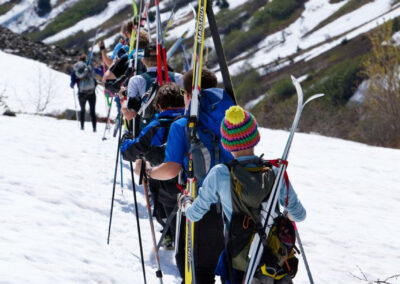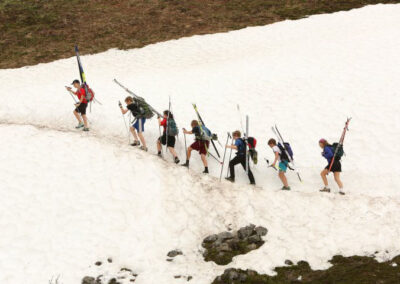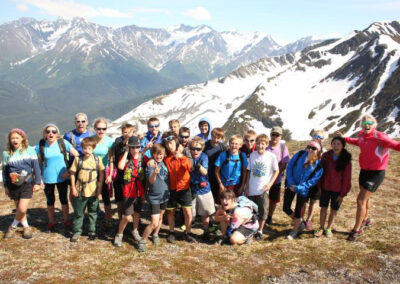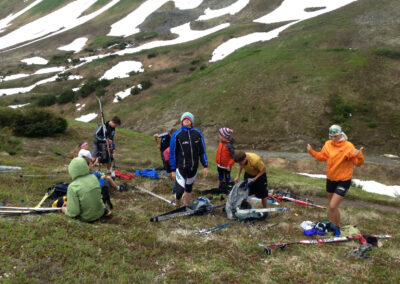Devo Program (6th-8th grade)
Devos is an early development program for cross-country ski racing for athletes in 6th-8th grade. The goal of the Devo program is to develop cross-country ski racing skills, promote general fitness, and create a love of the sport to last a lifetime.
APU has a strong tradition in Nordic skiing producing some of the best skiers in the US and the world, including Olympic Gold Medalist, overall World Cup Sprint Champion and former APU junior, Kikkan Randall. The Devo program is a great first step and it is a whole lot of fun!
During this phase in development, training should be broad based and include multiple sporting activities. During the summer, we promote ski training with a variety of activities, including running, hiking, roller skiing, ski imitation, and mountain biking. In winter all sessions are skiing, including classic and skate. We encourage athletes to participate in Besh Cups, Middle School skiing, cross-country running, and track.
Training is typically located at Hillside, APU, and Kincaid. Athletes will also take special training sessions to run in the mountains or ski other trails. Training sessions are typically 2-4 days a week.
Head Coach: Galen Johnston
Assistant Coaches: Anna Darnell, Sean Clapp, Anna Trujillo
Summer (April 29, 2024 to August 15, 2024) …….. $1,100
4 sessions per week, Monday through Thursday.
Times during the ASD school year are 4:45pm – 6:15pm. Times during ASD summer break are 10:45am – 12:15pm Monday, Tuesday and Wednesday, and 8:30am-10:30am Thursday.
Fall (August 19, 2024 to October 3, 2024) …….. $410
2-4 sessions per week, Monday through Thursday, 4:45pm – 6:15pm.
Winter (October 7, 2024 to April 3, 2025) ……. $1,340
2-4 sessions per week, Monday through Thursday, 4:45pm – 6:15pm.
Year Round (April 29, 2024 to April 3, 2025) …….. $2,280
All seasonal programs at reduced rate, bi-annual payment plan available.
- APU (map link) – Meet on the lawn in front of Atwood Center.
- Hilltop Ski Area (map link) – Meet at the far end of the inner parking area at the Nordic Ski Trailhead.
- Kincaid Park (map link) – Meet on the north side of the lower parking lot. (Below Gong Hill)
- Glen Alps (map link) – Meet at the main trailhead.
- Prospect Heights (map link) – Meet at the main trailhead.
- Upper Huffman (map link) – Meet at the main trailhead.
- Rabbit Lake Trailhead (map link) – Meet at the main trailhead.
Dryland (Summer/Fall)
- Running Shoes – Must be suitable for mountain running and muddy trails
- Bike Helmet
- Skate Roller Skis – Roller ski selection is based on both skill level and what ski boots you use. Beginner/Intermediate skiers will enjoy the added stability of the wider wheel of the Ski Skett Fire, Fischer RC5 skate, or similar. More advanced skiers will prefer a larger wheel diameter (narrower width) ski like the Swenor Alu Skate, Fischer RC7 Skate, or similar, which allow for a more natural ski feel. Junior athletes will be encouraged to move to this type of ski. Skiers who are in Junior model boot, or entry level skate boots may find this ski difficult to ski on. It’s always a good idea to rent skis from AMH to try them out before you purchase any model.
- Skate Ski Boots -This can be a combi style boot, but needs to offer enough ankle stability to avoid rolling in off of the ski. Make sure to pair an appropriate ski with the boot you have.
- Skate Roller Ski Poles – Skate poles should be roughly between chin and nose while standing in ski boots. For summer you need to swap the basket out for a ferrule that is more durable on pavement. AMH can take care of this for you!
- Classic or “Bounding” poles – For days that we run and bound with poles. Your winter classic poles will work just fine, though if you have something a little shorter (fit in the armpit) that is ideal. Often just with growth this is the perfect use of last winter’s classics.
- Mountain Bike – Good tire tread and mechanically sound. Riders need to be able to shift gears easily. Brakes should be in good working order.
- Drink Belt or Hydration Pack – For Mountain Run days it’s good to have a little water, a snack, and a way to carry a rain/wind jacket.
On Snow (Winter)
- Running Shoes – Studded shoes or removable ice cleats recommended
- Ski Boots – Combi boots work initially and are a great way to save cost. Designated skate and Classic boots help skiers develop good ski feel and balance. Eventually this is a good investment to make.
- Rock/Training Skis (Skate and Classic) – A separate pair of skis for both Skate and Classic techniques is ideal though not required. These are skis that are used when damage to the ski is likely to occur. Early season skiing, adventure skis, and game days are good times to utilize these skis. These skis also can function as warm-up skis before races when coaches are waxing race skis.
- Race Skis (Skate and Classic – A separate pair of skis for both Skate and Classic techniques.
- Skate Poles – Length should be between lower lip and nose.
- Classic Poles – Length to top of strap attachment should be 83% of body height standing in classic ski boots, or shorter.
Wax
- Classic Kick Wax – Lots of companies to choose from. Pick a basic line from one company and get to know it. One of each of the below waxes will cover most conditions.
- Cork – Synthetic Corks work most efficiently
- Binder – optional. Ironed onto bare base to increase kick and durability of kick wax layers.
- Blue – Swix V40, Toko Blue, Start Blue are all good options
- Violet – Swix V45 or V50, Start Purple, Toko Red
- Red – Swix V60, Toko Yellow, Start Red or Yellow
- Klister – Swix KX40S, Swix Silver Universal (can applicator is super easy)
- Glide Wax – Waxing skis regularly allows for skis to be faster and last longer. Feel free to ask for guidance. Below are two options.
- Hot wax – Wax applied with iron. Best durability but more investment. Requires: Waxing form, Waxing Iron, Wax (A “Green”, a “Blue” and a “Red” wax are good places to start), Glide Scraper, Groove scraper, Metal Brush (Copper or Steel), Nylon/Horsehair Brush
- Liquid glide wax – Wax applied from bottle, usually with sponge applicator. Less durable, but easier to apply. Requires less investment and is less likely to damage skis. Best applied after skiing and then brushed out prior to next ski. Requires: Wax, Brush (combi metal/nylon works well)
Clothing
- Hat – Something to keep your ears warm and your head covered.
- Gloves – Low profile but warm is ideal.
- Mittens – If your hands ever get cold check out Nordic specific mittens. They are thin, so they fit in ski pole straps, but also very warm!
- Buff – Or other face/neck cover. Just wearing this around your throat warms the air going into your lungs. Optional – Cold air Mask – Airtrim makes a good mask that allows air to be warmed and moisturized as it comes into your lungs. If you have trouble breathing in the cold, or simply want to look out for your lungs, this is a good thing to have in the kit! They’re great for warming up for cold races.
- Jacket – Something that you can move in that isn’t overly bulky, but will keep you warm. Ideally an outer material that snow doesn’t stick to too badly.
- Pants – Not overly bulky, but warm. Ideally an outer material that snow doesn’t stick to too badly.
- Long Underwear – Top and Bottom. Something other than cotton!
- Race suit – Optional. Spandex to race/train in. Wind Briefs – If you’re wearing a spandex suit and you’re a boy you need these. You will regret it if you don’t wear them.
- Drink Belt or water bottle carrier – Optional. If you like a little water on the ski this is a good investment.
- Boot Covers
- Besh Cups Races, organized by Cross Country Alaska, sanctioned by US Ski & Snowboard (must be a USSS member).
- Anchorage Cup Races organized by NSAA
- Middle School Racing organized by NSAA
- Registration Payments and Waivers All registration is online and required before attending the first session.
- Besh Cup Race Support is included in the Year Round and Winter membership fees.
- Family Discount After purchasing two year round memberships, all additional memberships are half price. Please contact coaches to get a registration coupon
- Payment Plans are available for year round memberships. The payment can be split into two payments, the first half is due before the first day of practice and the second half due October 1. To enroll, choose the year round payment plan option when registering.
- Helmets are required at all roller ski sessions. Necessary Equipment for the Devo Program can be found here.
- Basic Physical Fitness – Devos should be able to run or ski for 15-30 minutes without stopping and be able to move for over 90 minutes with short breaks.
- Health – Participants must be healthy to participate in practice. Stay home and take rest when you’re sick. Communicate with the Coach any existing injuries that may be affected by performing in our practice activities.
- Readiness – Participants are expected to arrive in time to receive important instructions given at the beginning of each practice, and with appropriate gear (see Equipment).
REGISTER ONLINE NOW
One-Week Trial Membership
If you want to check out the program before signing up, we offer a one-week trial membership for new members.
One Week Trial Registration »






